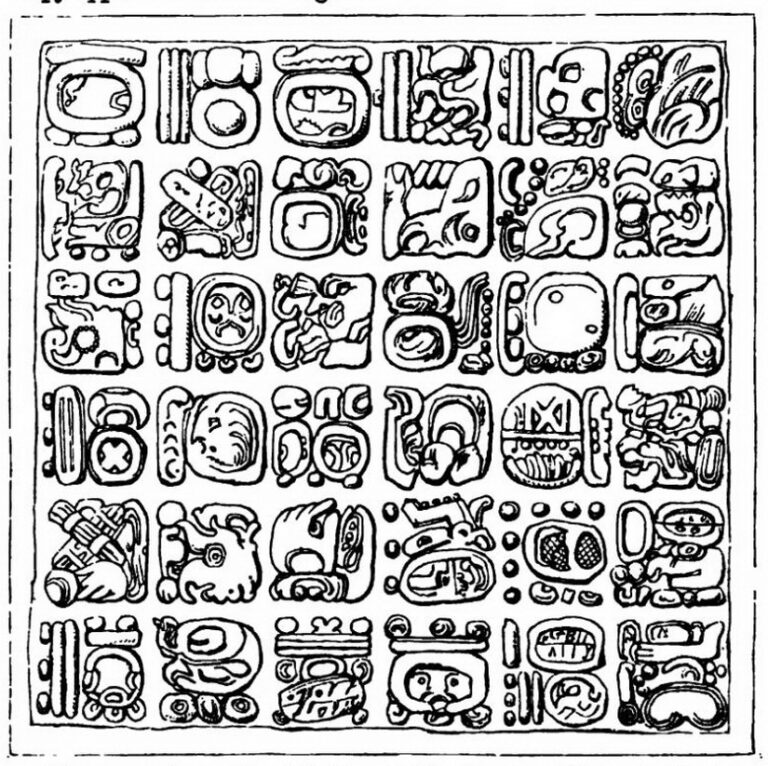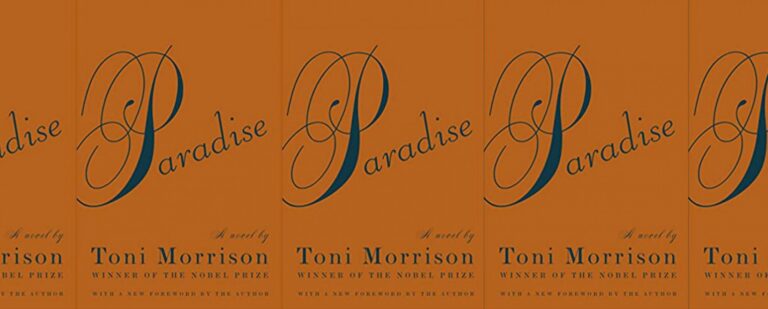Silvia Ferrara’s The Greatest Invention: A History of the World in Nine Mysterious Scripts and the Power of Written Language

The German-Swiss artist Paul Klee created “Once Emerged from the Gray of Night” in the waning days of World War I, when he was still mobilized, in 1918, in the German army. The war had already taken the life of his close friend and collaborator in the Expressionist Blaue Reiter group, August Macke. Klee and Macke traveled to Tunisia in 1914 and reveled in the city’s vivid light and color, but the world had changed by 1918, and Klee was in a much darker place. “The more horrifying this world becomes (as it is these days),” he wrote, “the more art becomes abstract.”
Like most of Klee’s work, “Once Emerged from the Gray of Night” is small, embracing the intimacy of the written page rather than the bold ambition of the painted canvas. The title is the first line of a poem that he composed and wrote in German at the top of the page: “Once emerged from the gray of night / that hard and costly / and thick with fire / the God-filled evening emerged and arches over / Now toward the ether, showering in blue / vanishing over glaciers / toward the wisdom of stars.” The poem repeats in the framed space of the paper, woven into a gridded plane of mosaic-like colors and forms. The poem’s letters emerge from the combination of lines and rounded shapes, the edges of the letters fusing with the bright patches of color. A strip of solid gray divides a field of vivid blue, yellow, purple, and green letter-forms into two halves, suggesting the trenches of World War I that were no doubt permanently etched in Klee’s mind. The poem can be read here, but reading it requires suppressing visual pleasure. The two experiences of seeing and reading are thus impossible to do at the same time.
Moments of existential sorrow can generate art of deep introspection. Klee’s passage into abstraction required a retreat from the picturing of Europe at war, which was certainly bleak beyond description, but Klee’s abstraction did not abandon all systems of communication. It involved an examination of the boundaries between picturing and writing, an investigation of whether it was possible to find a connection between letters and their visual form.
I read Silvia Ferrara’s The Greatest Invention: A History of the World in Nine Mysterious Scripts, published in March, during our own moment of existential sorrow, in which the United States seems to be unraveling into more senseless and horrifying injustices every day. Ferrara’s linguistic lessons might seem to have little to do with current catastrophes, yet I found solace in retreating into a topic so fundamental to the human experience. The Greatest Invention asks big questions about the very nature of the world’s most noteworthy writing systems. What is the distinction between writing and picture making? What do we mean when we say that a writing system was invented? What does it mean to invent something, anyway? As Klee recognized, an investigation of the boundary between seeing and reading can be a way to interrogate something fundamental about the human condition. Ferrara makes clear that the history of writing is the history of human connection. “Perhaps it’s true, then,” she writes, “that when it’s not tied to our emotions, our heart, our inescapable interconnectedness, writing has no purpose at all.” In other words, making a better world might require an examination of how we communicate. The writing systems that Ferrara explores in The Great Invention do not resemble Klee’s work—these systems had practical functions to consider, like recording the price of grain, reverence to a particular deity, or purposes yet to be uncovered—but like Klee’s “Once Emerged from the Gray of Night,” these ancient languages operated between text and image, forcing us to reconsider how we usually define the difference between the two.
Ferrara challenges the focus on phonetic notation in the history of written language. Sounds begin to take precedence over icons and figurative symbols around 2800 BCE in Mesopotamia, but Ferrara argues that despite the phonetic basis of the Latin alphabet, the human dependence on iconic meaning never really goes away. “The truth is that we’re hopelessly drawn to iconicity,” she writes, “icons have an undeniable gravitational force when it comes to scripts.” In this alternative history, Ferrara asks how we would understand our world differently if we prioritized the relationship between language and pictures. One thing that would change would be which systems of written language and which cultures get the most attention when the history of writing is told. One of the most inviting aspects of Ferrara’s history is its global approach, in which systems of language native to Easter Island are discussed on the same footing as those seen as more traditionally fundamental to the development of the Latin alphabet. Rather than being interested in discovering the first written language, she distrusts the emphasis placed on invention and revels in the astonishing diversity of written language systems that have developed separately from one another in the course of human history.
Ferrara explores the unmatched stability of the Chinese script, which has barely changed in millennia and apparently emerged in its highly complex form in its earliest moments of use at the end of the second millennium BCE. But Ferrara gives equal attention and respect to Rongorongo, a language illegible to scholars today but indigenous to the Pacific island of Rapa Nui. Because Rongorongo’s system of meaning is not yet understood, its script not legible, some scholars believe that it is not an actual script at all. Ferrara disagrees with these skeptics and walks us through how Rongorongo fulfills the criteria for written script. The language’s pictographic symbols operate in a consistent structure. There are indications that a spoken language was being recorded. European colonizers who eventually reached Rapa Nui were skeptical that the island’s inhabitants could invent a writing system on their own—but according to Ferrara, that is exactly what they did. The few examples that remain are written in boustrophedon, which means that the writing runs in a zigzag pattern that alternates from right to left and then from left to right. But as Ferrara explains, Rongorongo is even more unique. The writing in the second line is upside down to the first, which forces a spatially and visually aware process of turning the tablet (or turning one’s body) in order to read it. Ferrara calls it a kind of “advanced choreography,” and the practice of reading Rongorongo also sounds remarkably visual, even akin to viewing Klee’s poem.
To invent, we often assume, means to solve a problem, to meet a need. Yet this conception is often a product of hindsight. “We discover a thing first, only to later find it has a practical application, perhaps far different than what we’d initially imagined,” Ferrara explains. There was not one invention of writing, but many, each with its own idiosyncrasies and often emerging without influence from other writing systems. The reasons why some endured and some didn’t have less to do with their innate efficiency and sophistication than with the biases of scholars who look to explain and exalt the achievements of Western-European civilization.
Ferrara draws attention to this bias. Writing emerges, we have long been told, from the necessity of bureaucracy. Urban civilizations could not survive without written language, and vice versa. But again, this prioritizes some purposes of writing and obscures others. Ferrara attends to systems of writing that emerged far from cities and on the margins of ancient civilization. She discusses a system of writing that records the Canaanite dialect invented in the Sinai Peninsula, around 1900 BCE on a remote outpost of the Egyptian civilization: “We must rid ourselves of the idea that societies, in order to become the Leviathan that is the state, cannot survive without developing methods of control tied inextricably to the linguistic formalism of writing.” Ferrara thereby recuperates writing as more than a means of control and accounting. It emerges as a fundamental part of human pleasure. Tifinagh, for example, an ancient language native to Algeria, seems to have been developed for the pleasure of it. “It seems to have been invented for fun, for puzzle-making, for the occasional inscription or graffiti,” Ferrara writes. When looking at the photograph of the script in Ferrara’s book, it seems remarkable that it occurred to an expert that these marks were writing at all. It appears as a series of symbols, organized into a non-linear, grid-like pattern as meaningful as the symbols themselves.
Ferrara tells her history of writing systems while reflecting on her own writing process. “I’ve written it as if speaking to you,” she writes in the book’s Postscript, “as if writing never existed.” “I’ve purposefully given it an oral form, to get a sense of just how heavy the armor of writing can be.” Ferrara’s words (in Todd Pornowitz’s translation from the Italian) achieve a tone of colloquial conversation, which helps the reader wrap their head around the possibility of complex systems of meaning based in pictures, even though in many instances no one knows what they mean—only that they did mean. Ferrara provides casual summaries of some complex debates and topics in order to prioritize writing’s power to connect and help communicate. But in doing this, she also sets herself up for an impossible task. She tries to distance her writing from the conventions and structure that she examines in the book. Her writing style attempts to deprioritize the conventions and mechanics of the written Latin alphabet, referencing the spoken word rather than the formal conventions of written language as much as possible.
Ferrara’s history of the visual nature of written language ends with an examination of a more familiar iconic form: the emoji. “Emojis are not and never will be a written language,” she writes. Yet they seem fundamental to twenty-first century communication, and serve as a haunting reminder of what we’ve lost in our text-based, computer-driven, isolated world. “We have a deep need for images. A need to see things.” Emojis substitute for the nuance, gesture, and expression that is part of face-to-face communication. Consider how emojis try to overcome the tonelessness of texting. Sarcasm, exasperation, humor would be lost without the emoji, which proves how the pictorial might be supplemental to the textual, but is essential to human communication nonetheless.
There are more than seven thousand languages spoken throughout the world, many of them nearing extinction due to globalism and colonialist forces. Written languages are much rarer, and Ferrara reminds us that they are magical. The process of reading symbols that are turned into ideas, stories, and emotions in our minds and bodies is nothing short of miraculous. At times of injustice and tragedy caused by senseless human actions, it is helpful to recall the revolutionary power of writing from the broad perspective of the history of human existence. “Fear, rage, desire, pain,” Ferrara writes, “We must communicate them, to survive, to unite, to move forward.”


